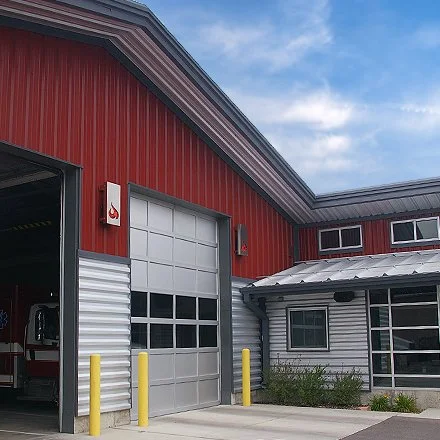Metal Building Window Guide
Looking to add more natural light to your space, but not sure what fits your needs and budget? This article outlines the various types of windows available for metal buildings, compares their benefits, and helps you determine the right choice for your project.
Windows play an important role in metal buildings — enhancing natural light, improving aesthetics, and contributing to energy efficiency. Unlike standard residential windows, windows in metal building systems must be compatible with steel framing and panel configurations, while standing up to environmental demands.
You have two options for getting more light into your building: windows and light transmitting panels.
Window vs Light Panel Overview
The table below provides a high-level overview to help you select the right sytem. From there, in-depth information is provided on different materials, types, and orientations of both windows and light-transmitting panels.
Key Factors to Consider
Climate: Insulated, Low-E glass windows can help to reduce energy bills in hot or cold regions
Code Compliance: Verify wind ratings, egress requirements, and ADA accessibility
| Feature | Windows | Light-Transmitting Panels |
|---|---|---|
| Transparency | High | Low–Moderate (diffused light) |
| Privacy | Low (when mounted at eye level) | High |
| Ventilation | Operable options | Non-operable |
| Insulation | Moderate–High | Low–Moderate (varies by panel type) |
| Application | Walls | Roofs, clerestories, industrial walls, gyms and athletic facilities |
| Material | Glass (often coated/treated) | Polycarbonate, FRP |
| Cost | Higher | Lower |
In-Depth Information
The information below provides more details on which solution will be right for you. It has information about window styles, frames, and materials as well as specific information related to light transmitting panel materials.
Windows
Aluminum, vinyl, or fiberglass frames with single-pane, dual-pane, or triple pane insulated glass
Window Styles
Fixed (Non-Operable) - Do not open or close
Low cost, less maintenance, highest energy efficiency
Sliding (Horizontal Slider) - Open horizontally, with one panel gliding past the other
Single-Hung and Double-Hung Windows
Single-hung: Bottom sash moves vertically; top is fixed
Double-hung: Both sashes move up and down
Framing and Mounting Options
Self-Framing Windows
Window frame includes integrated trim and mounting flange designed for panel ribs
Mount directly to wall panel, no opening framing required
Quick install, minimal field fabrication, aesthetically clean
Standard Window Framing (nail flange, flangless, etc.)
Window mounts to steel opening framing
Window is typically either flashed into WRB or flashed with metal trim to prevent water intrusion
More robust option with higher performance and lower likelihood of leakage
Window Frame Material Comparison
| Material | Pros | Cons |
|---|---|---|
| Vinyl & uPVC |
- Affordable - Good thermal insulation - Low maintenance - Resistant to moisture and rot |
- Limited color options - Can warp in extreme heat - Not as durable as metal or wood |
| Aluminum |
- Strong and lightweight - Sleek, modern appearance - Low maintenance - Ideal for large window spans |
- Poor thermal performance without thermal break |
| Wood |
- Traditional, premium look - Can be painted or stained |
- Requires regular maintenance - Susceptible to moisture, rot, and insects - Higher cost |
| Fiberglass |
- Very durable - Excellent thermal performance - Low expansion/contraction - Paintable |
- More expensive than vinyl - Fewer suppliers and design options |
Glazing Options
Single-Pane: Low cost, minimal insulation
Double-Pane (Insulated) & Triple-Pane: Better thermal and acoustic performance
Light Transmitting Panels
Provide diffused daylight into a space while maintaining insulation and privacy
Commonly used in roofing systems or high wall panels (e.g., clerestories)
Materials and layout impact designed for different levels of light diffusion, thermal insulation, durability, and cost-efficiency.
Here’s a breakdown of the most common types used in architecture and building systems:
Fiberglass Reinforced Panels
Polycarbonate Panels
Translucent Sandwich Panels
Fiberglass Reinforced Panels (FRP)
Made from translucent fiberglass embedded in resin
Usually available in corrugated or flat sheets
Pros
Low cost
High impact resistance
Long lifespan with UV-resistant coating
Cons
Lower light transmission (50–85%)
Yellow over time if not UV-stabilized
Best For
Warehouses, agricultural buildings
Polycarbonate Panels
Corrugated thermoplastic material with excellent transparency
Pros
Excellent light diffusion (up to 88%)
Very high impact resistance (250x stronger than glass)
Cons
More expensive than FRP
Higher thermal expansion and contraction
Best For
Greenhouses, clerestory windows, skylights
Translucent Sandwich Panels (Insulated LTPs)
Multi-layer composite panels with translucent polycarbonate or fiberglass skins and an insulating core
Available in full-wall, full-roof, skylight, and window applications
Pros
High R-values (thermal insulation)
Diffused natural light with low glare
Excellent for athletic facilities where glare can impact athlete performance
Cons
Higher initial cost
Specialized installation
Best For
Commercial facades, sports arenas, energy-efficient daylighting walls
Light Transmitting Panel Comparison Table
| Type | Light Transmission | Impact Resistance | Insulation Value | Typical Use |
|---|---|---|---|---|
| FRP Panels | 50–85% | Moderate | Low | Industrial roofs, greenhouses |
| Corrugated Polycarbonate | 75–88% | High | Low | Skylights, sheds, barns |
| Insulated Translucent Panels | 20–60% | High | Very High | LEED buildings, athletic facilities |
Light Transmitting Panel Cheat Sheet
| Priority | Recommended Panel Type |
|---|---|
| High impact resistance | Polycarbonate (multiwall/solid) |
| Low cost | FRP |
| Maximum insulation + light | Insulated sandwich panels |
| Clean appearance + clarity | Polycarbonate |
Conclusion
Metal building systems offer great flexibility in window choice — from economical fixed units to high-performance light transmitting panels. Whether your focus is on function, aesthetics, or energy savings, there's a window or light transmitting panel perfect for your application.























